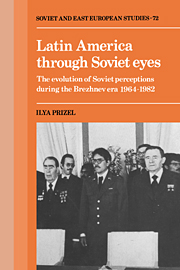 Latin America through Soviet Eyes
Latin America through Soviet Eyes Book contents
- Frontmatter
- Contents
- Preface
- Acknowledgments
- Introduction
- Part I Soviet perceptions of Latin America's global role
- Part II Soviet perceptions of Latin American social structures
- Introduction
- 6 The Latin American church
- 7 The Latin American armed forces
- 8 Latin American labor unions
- 9 Bourgeois political parties
- 10 Wars of national liberation or peaceful transformation?
- Part III Soviet–Latin American relations during the Brezhnev era
- Part IV Conclusion: the emerging Soviet perception of Latin America and the future of Soviet policy toward the hemisphere
- Conclusions
- Epilogue – Latin America: the Long March
- Notes
- Bibliography
- Index
6 - The Latin American church
Published online by Cambridge University Press: 05 February 2012
- Frontmatter
- Contents
- Preface
- Acknowledgments
- Introduction
- Part I Soviet perceptions of Latin America's global role
- Part II Soviet perceptions of Latin American social structures
- Introduction
- 6 The Latin American church
- 7 The Latin American armed forces
- 8 Latin American labor unions
- 9 Bourgeois political parties
- 10 Wars of national liberation or peaceful transformation?
- Part III Soviet–Latin American relations during the Brezhnev era
- Part IV Conclusion: the emerging Soviet perception of Latin America and the future of Soviet policy toward the hemisphere
- Conclusions
- Epilogue – Latin America: the Long March
- Notes
- Bibliography
- Index
Summary
Latin America is the most Catholic of all continents. All states have overwhelmingly Catholic majorities, and if the current demographic trends continue, by the end of this century more than half of the world's Catholics will be Latin Americans. The church's role in political life has always been a significant aspect of Latin America's social configuration since America's discovery was first financed by “Isabella the Catholic.” As in most parts of the world, the church was long identified with the most conservative stream in political life, supporting, for example, the imposition of serfdom on the Indian population of the New World and the introduction of African slaves. During the Latin American wars of independence, the church hierarchy remained loyal to the Spanish crown, thus clashing with the regimes of the new republics. When some Latin American states entered a liberal phase in the second half of the nineteenth century, the church opposed all reforms in a confrontation that in some cases led to the formal separation of church and state and confiscation of church lands. During most of the twentieth century the church remained, by and large, a conservative body in alliance with the latifundist (landowning) class, preaching obedience to the existing order and opposing social reorganization.
Yet despite its consistently conservative, if not reactionary position, the Latin American church was hardly ever a monolithic body. The lower clergy in particular often sided with revolutionary, antiestablishment political currents.
- Type
- Chapter
- Information
- Latin America through Soviet EyesThe Evolution of Soviet Perceptions during the Brezhnev Era 1964–1982, pp. 72 - 86Publisher: Cambridge University PressPrint publication year: 1990
